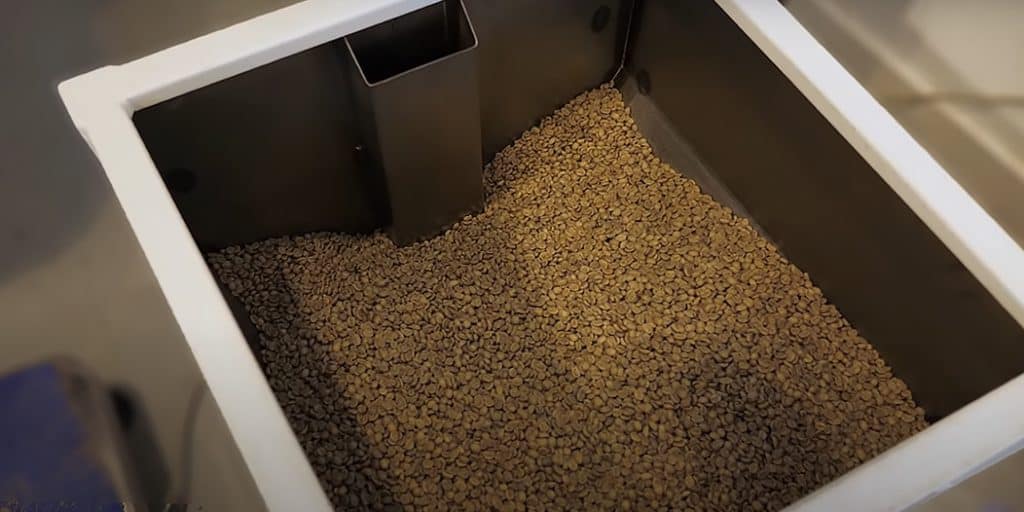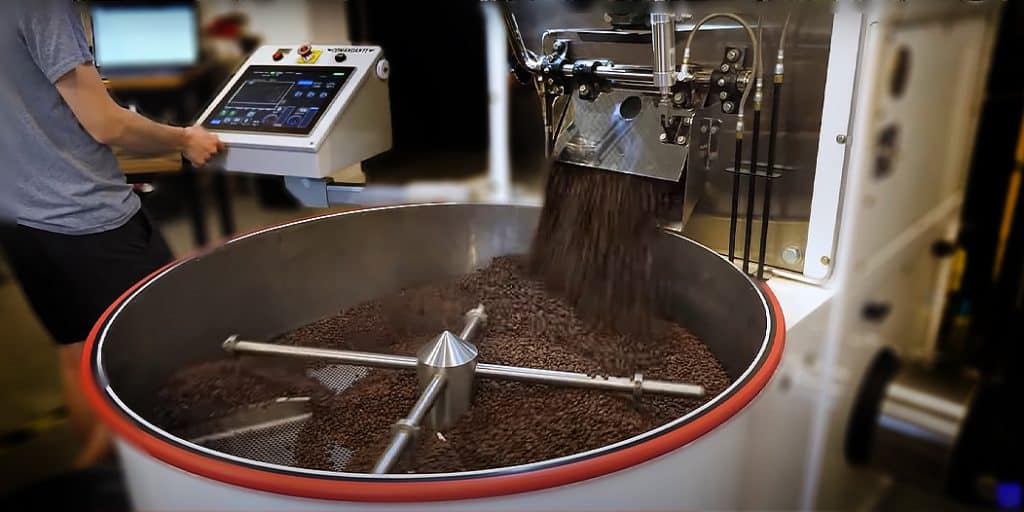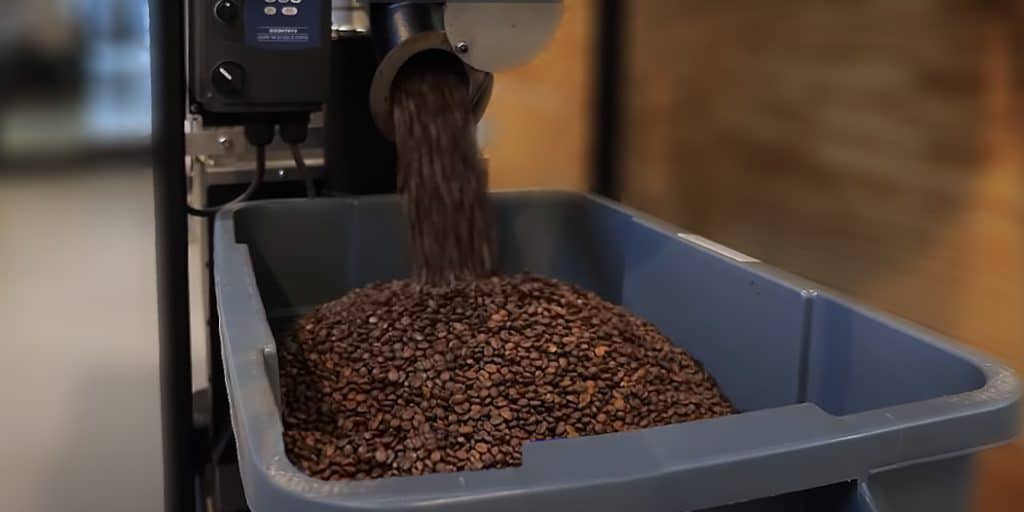How is coffee roasted? The complex phases of roasting explained
A raw green coffee bean doesn’t smell or taste anything like what we know as roasted coffee: it smells fresh and grassy.
It’s hard to imagine that green beans actually contain around 800 aromatic substances.
Sounds like a lot?
It is! Wine only has 500 identified aromas, much fewer than coffee.
What is coffee roasting, and what does it do?
Coffee roasting is the heat treatment of the coffee cherry’s green “seeds” (beans), whereby various chemical and physical transformations occur in them as they are heated for 10-20 minutes. Ultimately, this coffee roasting process is responsible for eliciting different flavors and aromas from the green coffee bean.
The phases of roasting: what happens during the roasting process?
The coffee beans undergo a series of different phases during the roasting process.
Here is an excellent video of the process, but read on after watching it to discover more secrets behind the trade.
While you can technically roast coffee beans at home, the real process is much more complex. Here is how roasting works in a drum roaster:
Phase 1 – Drying
The raw green beans are dropped into the drum preheated to around 250°C, which immediately cools the drum.

The “turning point” is when the temperature starts increasing again as the beans warm up to roasting temperature.
The drying phase begins when the beans have reached this turning point in the roaster.
Water begins to evaporate during the drying phase, and pressure slowly builds up in the bean.
Phase 2 – Browning (Maillard reaction)
The Maillard reaction kicks in when the beans reach an internal temperature of about 120°C. The beans begin to turn light brown and lose CO2, water, and other compounds.

The fructose in the beans caramelizes at about 160°C – 190°C, giving a sweet, caramel flavor depending on the sugar content. The combination of sugars such as glucose and lactose with amino acids results in the development of hundreds of new flavors.
Once the pressure in the bean builds enough and the size and volume increase, the beans open up (much like popcorn). This is called “first crack”, and typically occurs at 196°C.
Light roast coffee is complete at this stage.
Phase 3 – Roasting development
After the “First Crack,” the full flavor and aroma profiles start developing.

The fruit acids that formed in the first few minutes are increasingly reducing. The longer the coffee beans are roasted, the less acidic the coffee will be.
The beans start to lose their origin taste profile, which is substituted by caramel, chocolate, and bittersweet, woody aromas.
Oils appear on the surface of the beans, they become increasingly porous, and the color also becomes darker.
A “second crack” takes place at approx. 225°C. The gases released during roasting cause this, contrasting with the volume-induced first crack.
Caffeine is heat-resistant, therefore the caffeine content does not change with roast level. There is a misconception that darker roasts have less caffeine. They don’t.
However, pesticides are completely burnt away, so you can be sure that even non-organic coffees are safe to drink.
How do you know when each phase of roasting is reached?
There are various methods for determining a bean’s current degree of roast. A combination of bean temperature, odor, color, and sound (cracks) accurately determines the current roast level.
An experienced roast master is indispensable for the success of coffee roasting. He takes care of the composition of the coffee roast and monitors the roasting process, as he/she must stop it immediately after the desired degree of roast has been reached.
How long is coffee roasted?
The total amount of time a batch of coffee is roasted, and how the heat curve is developed, depends on the bean and the intended roast level.

Every coffee has a heat curve, final temperature, and total roast time. These are developed by combining the roaster’s experience, intuition, and experimentation.
A small batch roaster I talked to brought up interesting examples:
- He said his 2025 Yirgacheffe coffee reaches perfect roast at 385°F in 12:30,
- while his darker Honduran Espresso coffee will be roasted to 390°F in 15:10.
Weight, size, and consistency changes during roasting
The beans lose moisture and therefore 10-20% of their original weight during roasting. This presents a good form of quality control, where coffee roasters can weigh the coffee before and after roasting to maintain quality and consistency.
Meanwhile, decaffeinated coffee which already lost components such as caffeine, will have less change in the weight of its roasted yield compared to its caffeinated counterparts.
A rise in temperature inside the bean causes the water trapped inside to be released, changing the composition of the bean itself.
The bean decreases in overall mass as its water content drops from approximately 12% to around 2%, but gains 70-80% volume.

The roasting process also makes the beans more porous and, therefore, more water-soluble, which is important when brewing coffee.
As roast degree progresses past medium roast, oils migrate from the inside of the bean to the surface, making the bean shiny. In contrast, lighter roasts appear drier and deposit less oil in grinders than dark roasts.
The two main coffee roasting methods
In addition to the roasting time and temperature, the bean’s flavor is influenced by the roasting method.
The two methods of roasting you’ll encounter when shopping for coffee are:
Drum roasting
Used by small-batch roasters, drum roasting is the preferred method of roasting coffee.

This method lasts 13-25 minutes and reaches temperatures between 180°C and 240°C. This roasting process is complex and demanding, but gentler. It breaks down chlorogenic acids in the best possible way, allowing individual flavor nuances in the coffee to develop.
Hot-air roasting
This industrial coffee roasting method yields inferior results compared to drum roasting.

During hot-air roasting, temperatures rise to between 400°C and 600°C, so a roasting cycle only takes a few minutes. The coffee beans appear beautifully brown on the outside, but often remain raw on the inside. With these roasting processes, the taste of the coffee suffers considerably. The acid in the bean is not sufficiently reduced, and burnt aromas often prevail.
With both methods, the roasted coffee beans need to be cooled quickly after roasting is complete.
Cooling actually takes much longer than the roasting process. The beans cool on a sieve, or the roast master may use cold air as well.
How are coffee blends roasted?
When blending different types of coffee, there are two procedures for roasting.
- The first, is where the different varieties are roasted separately and only blended after their individual roasting is finished. This way, the roasting process responds individually to the different varieties, but different extraction profiles are created in the subsequent blend.
- The second is where the blended coffee beans are roasted together. Large-scale coffee companies follow this method during industrial roasting. The taste can be more balanced, but it is important to ensure that the various bean varieties’ sizes, hardness, and moisture content are similar. Otherwise, the roast will not be uniform across the beans.
Both methods can yield good results at the hands of experienced roasters.








You mention the second crack, and write it happens at approx. 225°C, but that’s a pretty high temperature that could risk burning the beans no? Perhaps I misunderstood? Could you clarify whether second crack temperatures can vary based on the bean type or roasting method?
Yes, that is a high temperature and going dark does mean that the beans might char.
I had an ahamoment reading this. Just last week, I tried roasting my own coffee in a pot but obviously couldn’t achieve that rich flavor. Understanding the Maillard reaction stages explains so much. I suppose it’s time to invest in a better roaster, or perhaps it’s the bean quality?
Wow, Tom, your deep dive into coffee roasting absolutely cleared up the confusion I had about why my home-roasted beans were so inconsistent, I never realized the importance of that turning pointduring drying. Because of your article. I’m eager to test out what I’ve learned, thank you for the eye-opener.
Fascinating article, Tom @ BigCupOfCoffee. The comparison of aroma compounds in wine vs. coffee was a surprise—one often thinks of wine as more complex. I’m curious, does elevation during the growing process impact the aromatic complexity post-roast too?